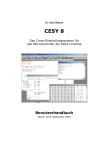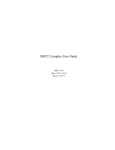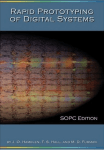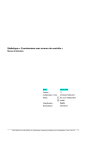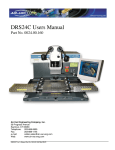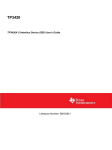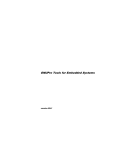Download User's Guide for Altera Nios™
Transcript
GNUPRO® TOOLKIT
User’s Guide for Altera Nios™
June 2000
Version 1.0
Copyright © 2000 Red Hat®, Inc. All rights reserved.
Red Hat®, the Red Hat Shadow Man logo, GNUPro®, and the GNUPro® logo are all
registered trademarks of Red Hat, Inc.
HP-UX® is a registered trademark of Hewlett-Packard® Company.
Solaris™ is a trademark of Sun® Microsystems, Inc.
Windows® is a registered trademark of Microsoft® Corporation, Inc.
UNIX® is a registered trademark of The Open Group.
All other brand and product names, trademarks, and copyrights are the property of
their respective owners.
No part of this document may be reproduced in any form or by any means without the
prior express written consent of Red Hat, Inc.
No part of this document may be changed an/or modified without the prior express
written consent of Red Hat, Inc.
GNUPro Warranty
The GNUPro Toolkit is free software, covered by the GNU General Public License,
and you are welcome to change it and/or distribute copies of it under certain
conditions. This version of GNUPro Toolkit is supported for customers of Red Hat.
For non-customers, GNUPro Toolkit software has NO WARRANTY.
Because this software is licensed free of charge, there are no warranties for it, to the
extent permitted by applicable law. Except when otherwise stated in writing, the
copyright holders and/or other parties provide the software “as is” without warranty of
any kind, either expressed or implied, including, but not limited to, the implied
warranties of merchantability and fitness for a particular purpose. The entire risk as to
the quality and performance of the software is with you. Should the software prove
defective, you assume the cost of all necessary servicing, repair or correction.
In no event, unless required by applicable law or agreed to in writing, will any
copyright holder, or any other party who may modify and/or redistribute the program
as permitted above, be liable to you for damages, including any general, special,
incidental or consequential damages arising out of the use or inability to use the
program (including but not limited to loss of data or data being rendered inaccurate or
losses sustained by you or third parties or a failure of the program to operate with any
other programs), even if such holder or other party has been advised of the possibility
of such damages.
ii ■ User’s Guide for Altera Nios
GNUPro Toolkit
How to Contact Red Hat
How to Contact Red Hat
Red Hat Corporate Headquarters
2600 Meridian Parkway
Durham, NC 27713 USA
Telephone (toll free): +1 888 REDHAT 1
Telephone (main line): +1 919 547 0012
Telephone (FAX line): +1 919 547 0024
Website: http://www.redhat.com/
Part #: 300-400-1010099-1.0
GNUPro Toolkit
User’s Guide for Altera Nios ■ iii
iv ■ User’s Guide for Altera Nios
GNUPro Toolkit
Contents
How to Contact Red Hat................................................................ iii
Introduction.......................................................................................1
Tool Naming Conventions ...............................................................1
Windows Environment Settings ......................................................2
Case Sensitivity ...............................................................................3
Toolkit Features ...............................................................................3
Processor Version .........................................................................3
Targets Supported .........................................................................3
Hosts Supported............................................................................4
Object File Format........................................................................4
Tutorials .............................................................................................5
Windows NT Operating System ......................................................7
Create Source Code ......................................................................7
Compile, Assemble and Link from Source Code.........................7
Run the Executable on the Stand-alone Simulator .......................8
Run Under the Debugger..............................................................8
Debug with the Built-in Simulator ...............................................9
Assembler Listing from Source Code ........................................ 11
Solaris 2.5.1 Operating System .....................................................12
Create Source Code ....................................................................12
Compile, Assemble and Link from Source Code.......................12
GNUPro Toolkit
User’s Guide for Altera Nios n v
Run the Executable on the Stand-alone Simulator .....................13
Run Under the Debugger............................................................13
Debug with the Built-in Simulator .............................................14
Assembler Listing from Source Code ........................................16
Reference..........................................................................................17
Compiler ........................................................................................18
Nios Command Line Options.....................................................18
Preprocessor Symbols ................................................................18
Nios Attributes............................................................................18
Limitations..................................................................................18
ABI Summary ................................................................................18
Data Type Sizes and Alignments................................................19
Floating-point .............................................................................19
Registers .....................................................................................19
Leaf Procedures ..........................................................................20
Stack Frame ................................................................................20
Argument Passing.......................................................................23
Return Values..............................................................................23
Assembler ......................................................................................24
Nios Command Line Options.....................................................24
Syntax .........................................................................................24
Special Characters ......................................................................24
Register Names...........................................................................24
Addressing Modes .....................................................................25
@h Modifier ...............................................................................25
Pseudo-ops..................................................................................26
Data Alignment ..........................................................................27
Condition Code Specifiers..........................................................27
Floating-point .............................................................................28
Opcodes ......................................................................................29
Linker.............................................................................................29
Nios Command Line Options.....................................................29
Linker Script...............................................................................29
Debugger........................................................................................30
Nios Command Line Options.....................................................30
Simulator........................................................................................31
Bibliography ....................................................................................33
vi n User’s Guide for Altera Nios
GNUPro Toolkit
Introduction
The GNUPro® Toolkit from Red Hat is a complete solution for C and C++
development for the Altera Nios™. The tools include the compiler, interactive
debugger and utilities libraries. The User’s Guide for Altera Nios consists of the
following sections:
■
Introduction
An introduction to the features of the GNUPro Toolkit.
■
Reference
Nios-specific features of the main GNUPro Tools.
■
Bibliography
Tool Naming Conventions
Cross-development tools in the Red Hat GNUPro Toolkit normally have names that
reflect the target processor and the object file format that is output by the tools
(for example, ELF). This makes it possible to install more than one set of tools in the
same binary directory, including both native and cross-development tools.
The complete tool name is a three-part hyphenated string. The first part indicates the
GNUPro Toolkit
User’s Guide for Altera Nios ■ 1
Introduction
processor family and the mode of operation (nios). The second part indicates the file
format output by the tool (elf). The third part is the generic tool name (gcc). For
example, the GCC ELF compiler for the Altera Nios is
nios-elf-gcc.
The binaries for a Windows 95/NT hosted toolchain are installed with an .exe suffix.
However, the .exe suffix does not need to be specified when running the executable.
The Nios package includes the following supported tools:
Tool Description
Tool Name
GCC compiler
nios-elf-gcc
C++ compiler
nios-elf-g++
GAS assembler
nios-elf-as
GLD linker
nios-elf-ld
Standalone simulator
nios-elf-run
Binary Utilities
nios-elf-ar
nios-elf-dlltool
nios-elf-nm
nios-elf-objcopy
nios-elf-objdump
nios-elf-ranlib
nios-elf-readelf
nios-elf-size
nios-elf-strings
nios-elf-strip
GDB debugger
nios-elf-gdb
Windows Environment Settings
For the Windows 95/NT toolchain the libraries are installed in different locations.
Therefore, the Windows 95/NT hosted toolchain requires the following environmental
settings to function properly. Assume the release is installed in C:\REDHAT.
SET
SET
SET
REM
SET
PROOT=C:\redhat\nios-yymmdd
PATH=%PROOT%\H-i686-cygwin32\BIN;%PATH%
INFOPATH=%PROOT%\info
Set TMPDIR to point to a ramdisk if you have one
TMPDIR=%PROOT%
NOTE: The variable yymmdd indicates the release date printed on the CD-ROM.
2 ■ User’s Guide for Altera Nios
GNUPro Toolkit
Case Sensitivity
Case Sensitivity
The following strings are case sensitive under UNIX and Windows 95/NT:
■
command line options
■
assembler labels
■
linker script commands
■
section names
■
file names within makefiles
■
file names are case sensitive under UNIX
The following strings are not case sensitive under UNIX or Windows 95/NT:
■
GDB commands
■
assembler instructions and register names
Case sensitivity for Windows 95/NT is dependent on system configuration. By
default, file names under Windows 95/NT are not case sensitive.
It is important to remember that the GNUPro Toolkit is case sensitive. Therefore,
enter all commands and options exactly as indicated in this document.
Toolkit Features
The following describes Altera Nios-specific features of the GNUPro Toolkit.
Processor Version
Altera Nios
Targets Supported
GNUPro Instruction Set Simulator
GNUPro Toolkit
User’s Guide for Altera Nios ■ 3
Introduction
Hosts Supported
CPU
Operating System
Vendor
PA-RISC
HPUX-10.20 and HPUX-11.0
Hewlett-Packard
SPARC
Solaris 2.5.1 and Solaris 2.6
Sun
x86
Windows NT
Microsoft
Object File Format
The Nios tools support the ELF object file format. Refer to Chapter 4, System V
Application Binary Interface (Prentice Hall, 1990.). Use ld (refer to Using LD in
GNUPro Utilities) or objcopy (refer to The GNU Binary Utilities in GNUPro
Utilities) to produce S-records.
4 ■ User’s Guide for Altera Nios
GNUPro Toolkit
1
Tutorials
This section gives examples of how to use the main utilities. For more detail, refer to
the individual utility manuals.
It is important to remember that the GNUPro Toolkit is case sensitive on all operating
systems. Therefore, enter all commands and options exactly as indicated in this
document.
GNUPro Toolkit
User’s Guide for Altera Nios ■ 5
Tutorials
The following chart outlines the sequence of steps in the tutorial. The assembler
listing from source code is optional.
Create source
code
Compile,
assemble and link
from source code
Run executable on
the stand-alone
simulator
Assembler listing
from source code
Run under the
debugger
Debug with the
built-in simulator
6 ■ User’s Guide for Altera Nios
GNUPro Toolkit
Windows NT Operating System
Windows NT Operating System
The following examples for the Windows NT operating system were created using
GDB (GNUPro Debugger) in command-line mode. They may also be reproduced
using the command prompt in the Console Window of Red Hat Insight (the GUI
interface to the GNUPro Debugger).
Create Source Code
Create the following sample source code and save it as hello.c. Use this program to
verify correct installation.
#include <stdio.h>
int a, c;
void foo(int b)
{
c = a + b;
printf("%d + %d = %d\n", a, b, c);
}
int main()
{
int b;
a = 3;
b = 4;
printf("Hello, world!\n");
foo(b);
return 0;
}
Compile, Assemble and Link from Source Code
Throughout these examples, screen samples are shown with a gray background. Code
input is shown in plain monofont. Code output is shown in bold monofont. For
Windows NT the command prompt is shown as C:\>.
To compile this example to run on the simulator:
C:\> nios-elf-gcc -Tsim.ld -g hello.c -o hello.exe
To link an executable for the simulator, the correct linker script must be specified with
the -Tsim.ld option.
The -g option generates debugging information and the -o option specifies the name
of the executable to be produced. Other useful options include -O for standard
optimization, and -O2 for extensive optimization. When no optimization option is
GNUPro Toolkit
User’s Guide for Altera Nios ■ 7
Tutorials
specified GCC will not optimize. Refer to “GNU CC Command Options” in Using
GNU CC in GNUPro Compiler Tools for a complete list of available options.
Run the Executable on the Stand-alone Simulator
To run this program on the stand-alone simulator, enter:
C:\> nios-elf-run hello.exe
hello world!
3 + 4 = 7
C:\>
The simulator executes the program, and returns when the program exits.
Run Under the Debugger
GDB can debug programs by using the built-in simulator (this does not require access
to any hardware). To start GDB enter the command:
nios-elf-gdb -nw hello.exe
After the initial copyright and configuration information GDB returns its own prompt:
(gdb).
C:\> nios-elf-gdb -nw hello.exe
GNU gdb 4.17-nios-990519 Copyright 1999 Free Software Foundation, Inc.
GDB is free software, covered by the GNU General Public License, and you are
welcome to change it and/or distribute copies of it under certain conditions.
Type "show copying" to see the conditions. There is absolutely no warranty for
GDB. Type "show warranty" for details. This GDB was configured as
"--host=i686-cygwin --target=nios-elf"...
(gdb)
In our examples, the -nw option was used to select the command line interface to GDB
(the Red Hat Insight interface is the default). The -nw is useful for making transcripts
such as the one above. The -nw option is also useful when you wish to report a bug in
GDB, because a sequence of commands is simpler to reproduce.
To exit GDB, enter the quit command at the (gdb) prompt.
gdb) quit
C:\>
8 ■ User’s Guide for Altera Nios
GNUPro Toolkit
Windows NT Operating System
Debug with the Built-in Simulator
The following is a sample debugging session using the target sim command to
specify the GNUPro Instruction Set Simulator as the target:
C:\> nios-elf-gdb -nw hello.exe
GNU gdb 4.17-nios-990519 Copyright 1999 Free Software Foundation, Inc.
GDB is free software, covered by the GNU General Public License, and you are
welcome to change it and/or distribute copies of it under certain conditions.
Type "show copying" to see the conditions. There is absolutely no warranty for
GDB. Type "show warranty" for details. This GDB was configured as
"--host=i686-cygwin --target=nios-elf"...
(gdb) target sim
Connected to the simulator.
(gdb) load
Loading section .init, size 0x10 lma 0x0
Loading section .text, size 0xad6e lma 0x10
Loading section .fini, size 0x8 lma 0xad7e
Loading section .rodata, size 0x372 lma 0xad88
Loading section .data, size 0x3d6 lma 0xb0fc
Loading section .ctors, size 0x4 lma 0xb4d2
Loading section .dtors, size 0x4 lma 0xb4d6
Loading section .eh_frame, size 0x1054 lma 0xff04
Start address 0x10
Transfer rate: 403792 bits in <1 sec.
(gdb) break main
Breakpoint 1 at 0x132: file hello.c, line 15.
(gdb) run
Starting program: C:\hello.exe
Breakpoint 1, main () at hello.c:15
15
a = 3;
(gdb) print a
$1 = 0
(gdb) step
16
b = 4;
(gdb) print a
$2 = 3
(gdb) list
11
int main()
12
{
GNUPro Toolkit
User’s Guide for Altera Nios ■ 9
Tutorials
13
14
15
16
17
18
19
20
int b;
a = 3;
b = 4;
printf("Hello, world!\n");
foo(b);
return 0;
}
(gdb) list foo
1
#include <stdio.h>
2
3
int a, c;
4
5
void foo(int b)
6
{
7
c = a + b;
8
printf("%d + %d = %d\n", a, b, c);
9
}
10
(gdb) break 7
Breakpoint 2 at 0xf4: file hello.c, line 7.
(gdb) continue
Continuing.
Hello, world!
Breakpoint 2, foo (b=4) at hello.c:7
7
c = a + b;
(gdb) step
8
printf("%d + %d = %d\n", a, b, c);
(gdb) print c
$3 = 7
(gdb) next
3 + 4 = 7
9
}
(gdb) backtrace
#0 foo (b=4) at hello.c:9
#1 0x15c in main () at hello.c:18
(gdb) quit
The program is running.
C:\>
Quit anyway (and kill it)? (y or n) y
10 ■ User’s Guide for Altera Nios
GNUPro Toolkit
Windows NT Operating System
Assembler Listing from Source Code
The following command produces an assembler listing:
nios-elf-gcc -g -O2 -Wa,-al -c hello.c
The compiler debugging option -g gives the assembler the necessary debugging
information. The -O2 option produces optimized code output. The -Wa option tells the
compiler to pass the text immediately following the comma as a command line to the
assembler. The assembler option -al requests an assembler listing. The -c option tells
GCC to compile or assemble the source files, but not to link. Here is a partial excerpt
of the output.
57
58
59
60
61
62
63
64
65
66
67
68
69
70
71
72
73
74
75
76
77
78
79
80
81
82
83
84
85
86
87
88
89
90
91
92
001d 00
.text
.p2align 1
.globl main
.type
main,@function
main:
.LFB2:
.LM5:
0024 2E78
; start prologue
save %sp, -46
.LCFI1:
; end prologue
.LM6:
.LBB2:
.LM7:
0026
0028
002a
002c
0098
1034
6134
01A0
pfx
movi
movi
stp
%hi(a)
%l0, %lo(a)
%g1, 3
[%l0, 0], %g1
pfx
movi
pfx
movi
call
nop
%hi(.LC1)
%o0, %lo(.LC1)
%hi(printf@h)
%g1, %lo(printf@h)
%g1
movi
pfx
movi
call
nop
%o0, 4
%hi(foo@h)
%g1, %lo(foo@h)
%g1
.LM8:
002e
0030
0032
0034
0036
0038
0098
0834
0098
0134
E17F
0030
.LM9:
003a
003c
003e
0040
0042
8834
0098
0134
E17F
0030
GNUPro Toolkit
User’s Guide for Altera Nios ■ 11
Tutorials
Solaris 2.5.1 Operating System
The following examples for the Solaris 2.5.1 operating system were created using GDB
(GNUPro Debugger) in command-line mode. They may also be reproduced using the
command prompt in the Console Window of Red Hat Insight (the GUI interface to
the GNUPro Debugger).
Create Source Code
Create the following sample source code and save it as hello.c. Use this program to
verify correct installation.
#include <stdio.h>
int a, c;
void foo(int b)
{
c = a + b;
printf("%d + %d = %d\n", a, b, c);
}
int main()
{
int b;
a = 3;
b = 4;
printf("Hello, world!\n");
foo(b);
return 0;
}
Compile, Assemble and Link from Source Code
Throughout these examples, screen samples are shown with a gray background. Code
input is shown in plain monofont. Code output is shown in bold monofont. For Solaris
2.5.1, the command prompt is shown as %.
To compile this example to run on the simulator:
% nios-elf-gcc -Tsim.ld -g hello.c -o hello
To link an executable for the simulator, the correct linker script must be specified with
the -Tsim.ld option.
The -g option generates debugging information and the -o option specifies the name
of the executable to be produced. Other useful options include -O for standard
optimization, and -O2 for extensive optimization. When no optimization option is
12 ■ User’s Guide for Altera Nios
GNUPro Toolkit
Solaris 2.5.1 Operating System
specified GCC will not optimize. Refer to “GNU CC Command Options” in Using
GNU CC in GNUPro Compiler Tools for a complete list of available options.
Run the Executable on the Stand-alone Simulator
To run this program on the stand-alone simulator, enter:
% nios-elf-run hello
hello world!
3 + 4 = 7
%
The simulator executes the program, and returns when the program exits.
Run Under the Debugger
GDB can be used to debug executables using the GNUPro Instruction Set Simulator.
To start GDB enter the command:
nios-elf-gdb -nw hello
After the initial copyright and configuration information GDB returns its own prompt:
(gdb).
% nios-elf-gdb -nw hello
GNU gdb 4.17-nios-990519 Copyright 1999 Free Software Foundation, Inc.
GDB is free software, covered by the GNU General Public License, and you are
welcome to change it and/or distribute copies of it under certain conditions.
Type "show copying" to see the conditions. There is absolutely no warranty for
GDB. Type "show warranty" for details. This GDB was configured as
"--host=sparc-sun-solaris2.5.1 --target=nios-elf"...
(gdb)
In our examples, the -nw option was used to select the command line interface to GDB
(the Red Hat Insight interface is the default), which is useful for making transcripts
such as the one above. The -nw option is also useful when you wish to report a bug in
GDB, because a sequence of commands is simpler to reproduce.
To exit GDB, enter the quit command at the (gdb) prompt.
gdb) quit
%
GNUPro Toolkit
User’s Guide for Altera Nios ■ 13
Tutorials
Debug with the Built-in Simulator
The following is a sample debugging session using the target sim command to
specify the GNUPro Instruction Set Simulator as the target:
% nios-elf-gdb -nw hello
GNU gdb 4.17-nios-990519 Copyright 1999 Free Software Foundation, Inc.
GDB is free software, covered by the GNU General Public License, and you are
welcome to change it and/or distribute copies of it under certain conditions.
Type "show copying" to see the conditions. There is absolutely no warranty for
GDB. Type "show warranty" for details. This GDB was configured as
"--host=sparc-sun-solaris2.5.1 --target=nios-elf"...
(gdb) target sim
Connected to the simulator.
(gdb) load
Loading section .init, size 0x10 lma 0x0
Loading section .text, size 0xad6e lma 0x10
Loading section .fini, size 0x8 lma 0xad7e
Loading section .rodata, size 0x372 lma 0xad88
Loading section .data, size 0x3d6 lma 0xb0fc
Loading section .ctors, size 0x4 lma 0xb4d2
Loading section .dtors, size 0x4 lma 0xb4d6
Loading section .eh_frame, size 0x1054 lma 0xff04
Start address 0x10
Transfer rate: 403792 bits in <1 sec.
(gdb) break main
Breakpoint 1 at 0x132: file hello.c, line 15.
(gdb) run
Starting program: /home/nios/hello
Breakpoint 1, main () at hello.c:15
15
a = 3;
(gdb) print a
$1 = 0
(gdb) step
16
b = 4;
(gdb) print a
$2 = 3
(gdb) list
11
int main()
12
{
14 ■ User’s Guide for Altera Nios
GNUPro Toolkit
Solaris 2.5.1 Operating System
13
14
15
16
17
18
19
20
int b;
a = 3;
b = 4;
printf("Hello, world!\n");
foo(b);
return 0;
}
(gdb) list foo
1
#include <stdio.h>
2
3
int a, c;
4
5
void foo(int b)
6
{
7
c = a + b;
8
printf("%d + %d = %d\n", a, b, c);
9
}
10
(gdb) break 7
Breakpoint 2 at 0xf4: file hello.c, line 7.
(gdb) continue
Continuing.
Hello, world!
Breakpoint 2, foo (b=4) at hello.c:7
7
c = a + b;
(gdb) step
8
printf("%d + %d = %d\n", a, b, c);
(gdb) print c
$3 = 7
(gdb) next
3 + 4 = 7
9
}
(gdb) backtrace
#0 foo (b=4) at hello.c:9
#1 0x15c in main () at hello.c:18
(gdb) quit
The program is running.
%
GNUPro Toolkit
Quit anyway (and kill it)? (y or n) y
User’s Guide for Altera Nios ■ 15
Tutorials
Assembler Listing from Source Code
The following command produces an assembler listing:
nios-elf-gcc -g -O2 -Wa,-al -c hello.c
The compiler debugging option -g gives the assembler the necessary debugging
information. The -O2 option produces optimized code output. The -Wa option tells the
compiler to pass the text immediately following the comma as a command line to the
assembler. The assembler option -al requests an assembler listing. The -c option tells
GCC to compile or assemble the source files, but not to link. Here is a partial excerpt
of the output.
57
58
59
60
61
62
63
64
65
66
67
68
69
70
71
72
73
74
75
76
77
78
79
80
81
82
83
84
85
86
87
88
89
90
91
92
001d 00
.text
.p2align 1
.globl main
.type
main,@function
main:
.LFB2:
.LM5:
0024 2E78
; start prologue
save %sp, -46
.LCFI1:
; end prologue
.LM6:
.LBB2:
.LM7:
0026
0028
002a
002c
0098
1034
6134
01A0
pfx
movi
movi
stp
%hi(a)
%l0, %lo(a)
%g1, 3
[%l0, 0], %g1
pfx
movi
pfx
movi
call
nop
%hi(.LC1)
%o0, %lo(.LC1)
%hi(printf@h)
%g1, %lo(printf@h)
%g1
movi
pfx
movi
call
nop
%o0, 4
%hi(foo@h)
%g1, %lo(foo@h)
%g1
.LM8:
002e
0030
0032
0034
0036
0038
0098
0834
0098
0134
E17F
0030
.LM9:
003a
003c
003e
0040
0042
8834
0098
0134
E17F
0030
16 ■ User’s Guide for Altera Nios
GNUPro Toolkit
2
Reference
This section describes the ABI and Nios-specific attributes of the main GNUPro tools.
■
Compiler
■
ABI Summary
■
Assembler
■
Linker
■
Debugger
■
Simulator
GNUPro Toolkit
User’s Guide for Altera Nios ■ 17
Reference
Compiler
This section describes Nios-specific features of the GNUPro Compiler.
Nios Command Line Options
For a list of available generic compiler options, refer to “GNU CC Command
Options” in Using GNU CC in GNUPro Compiler Tools. In addition, the following
Nios-specific command line options are supported:
-m16
Generate code for the Nios-16 processor (default).
-m32
Generate code for the Nios-32 processor.
Preprocessor Symbols
The compiler supports the following preprocessor symbols:
__nios__
Is always defined.
__nios16__
Defined by default or if -m16 is used.
__nios32__
Defined if -m32 is used.
Nios Attributes
There are no Nios-specific attributes. See “Declaring Attributes of Functions” and
“Specifying Attributes of Variables” in “Extensions to the C Language Family” in
Using GNU CC in GNUPro Compiler Tools for more information.
Limitations
The unary operator &&, a GNU extension which allows labels to be treated as values, is
not supported for the Nios processor. This limitation stems from the fact that code
pointers and data pointers are treated differently by the processor.
ABI Summary
The Altera Nios toolchain supports the Altera Nios ABI.
18 ■ User’s Guide for Altera Nios
GNUPro Toolkit
ABI Summary
Data Type Sizes and Alignments
The following table shows the size and alignment for all data types:
Type
Size (16-bit)
Size (32-bit)
char
1 byte
1 byte
short
2 bytes
2 bytes
int
2 bytes
4 bytes
long
4 bytes
4 bytes
long long
8 bytes
8 bytes
float
4 bytes
4 bytes
double
8 bytes
8 bytes
long double
8 bytes
8 bytes
■
■
■
■
■
■
■
For the Nios-16 processor, word and pointer size is two bytes.
For the Nios-32 processor, word and pointer size is four bytes.
Functions are aligned to two byte boundaries.
Data elements are aligned to their natural boundary up to a maximum of 32 bits.
Structures, unions and strings are always word-aligned.
Bitfields inside structures are always word-aligned.
All alignments are strict.
Floating-point
All floating-point values are emulated using IEEE floating-point conventions.
Registers
Out Registers
%o0
%o1
%o2
%o3
%o4
%o5
%o6
%o7
Description
%r8
%r9
%r10
%r11
%r12
%r13
%r14
%r15
Return value, call-clobbered
Call-clobbered
Call-clobbered
Call-clobbered
Call-clobbered
Call-clobbered
Stack pointer, call-preserved
Link register, call-preserved
Local Registers
Description
%l0
%l1
%l2
Call-preserved
Call-preserved
Call-preserved
GNUPro Toolkit
%r16
%r17
%r18
User’s Guide for Altera Nios ■ 19
Reference
%l3
%l4
%l5
%l6
%l7
%r19
%r20
%r21
%r22
%r23
Call-preserved
Call-preserved
Call-preserved
Call-preserved
Call-preserved
Global Registers
Description
%g0
%g1
%g2
%g3
%g4
%g5
%g6
%g7
Call-clobbered
Call-clobbered
Static chain, call-clobbered
Call-clobbered
Call-clobbered
Call-clobbered
Call-clobbered
Call-clobbered
%r0
%r1
%r2
%r3
%r4
%r5
%r6
%r7
In Registers
%i0
%i1
%i2
%i3
%i4
%i5
%i6
%i7
Description
%r24
%r25
%r26
%r27
%r28
%r29
%r30
%r31
Argument register 1, call-preserved
Argument register 2, call-preserved
Argument register 3, call-preserved
Argument register 4, call-preserved
Argument register 5, call-preserved
Argument register 6, call-preserved
Frame and argument pointer, call-preserved
Return address, call-preserved
Leaf Procedures
Leaf procedures are those procedures that do not call any other procedures. Some leaf
procedures can be transformed to use their caller’s register window and stack frame.
This saves execution time and memory, and can be done when the candidate leaf
procedure meets the following conditions:
■
The procedure contains no references to %sp, except in its save instruction.
■
It contains no references to %fp.
■
It refers to no more than 15 of the 32 registers, including the return address
register, %o7.
When optimized, a leaf procedure will use its caller’s stack frame and registers, and it
will only use registers %o0 through %o5, %o7, and %g0 through %g7.
Stack Frame
This section describes the Altera Nios stack frame.
20 ■ User’s Guide for Altera Nios
GNUPro Toolkit
ABI Summary
The stack grows downwards from high addresses to low addresses.
A leaf function is not required to allocate a stack frame if one is not needed.
The ABI requires a frame pointer to be allocated if any stack is allocated. In other
words, a leaf function that uses no stack does not allocate a frame pointer, but a leaf
function that uses stack or a non-leaf function requires a frame pointer.
Normally a stack frame, is allocated for each procedure. Under certain conditions,
optimization may enable a leaf procedure to use its caller’s stack frame instead of one
of its own. In that case, the procedure allocates no space of its own for a stack frame.
The following description of the memory stack applies to all procedures, except leaf
procedures which have been optimized in this way.
At compile time, sixteen words are always allocated in every procedure’s stack frame,
always starting at %sp, for saving the procedure’s “in” and “local” registers, should a
register window overflow occur.
At compile time, the following are allocated in the stack frames of non-leaf
procedures:
■
One word, for passing a hidden (implicit) parameter. This is used when the caller
is expecting the callee to return a data aggregate by value. The hidden word
contains the address of stack space allocated (if any) by the caller for that purpose.
■
Six words, into which the callee may store parameters that must be addressable
At compile time space is allocated as needed in the stack frame for the following:
■
Outgoing parameters beyond the sixth
■
All automatic arrays, automatic data aggregates, automatic scalars which must be
addressable, and automatic scalars for which there is no room in registers
■
Compiler-generated temporary values (typically when there are too many for the
compiler to keep them all in registers)
At runtime, space can be allocated dynamically in the stack frame for memory
allocated using the alloca() function of the C library.
Addressable automatic variables on the stack are addressed with negative offsets
relative to %fp. Dynamically allocated space is addressed with positive offsets from
the pointer returned by alloca(). Everything else in the stack frame is addressed with
positive offsets relative to %sp.
The following stack frame diagram is for both functions that take a fixed number or
variable number of arguments.
GNUPro Toolkit
User’s Guide for Altera Nios ■ 21
Reference
High
memory
SP+46
SP+34
SP+32
SP
After call:
Before call:
Caller’s locals
Caller’s locals
alloca() space
alloca() space
Arguments past the
6th argument
Six words to save
arguments passed in
registers, even if not
passed
One word hidden
address for callee to
store aggregate return
values
Arguments past the
6th argument
Six words to save
arguments passed in
registers, even if not
passed
One word hidden
address for callee to
store aggregate return
values
Sixteen word
register save area
FP+46
FP+34
FP+32
FP
Sixteen word
register save area
Callee’s locals
Registers saved
alloca() space
SP+46
SP+34
SP+32
Low
memory
22 ■ User’s Guide for Altera Nios
SP
Arguments past the
6th argument
Six words to save
arguments passed in
registers, even if not
passed
One word hidden
address for callee to
store aggregate return
values
Sixteen word
register save area
GNUPro Toolkit
ABI Summary
Argument Passing
Function arguments are passed in registers %o0 through %o5, with lower-numbered
registers being allocated to earlier arguments. Registers are allocated consecutively,
with no gaps. When all six registers have been filled, any remaining arguments are
placed in the stack argument area, allocating from lower to higher addresses. Each
argument starts on a word boundary.
■
Any argument whose address is not needed and it is four words in size or smaller,
whether scalar (e.g., integers, floats) or aggregate (e.g., structures, unions) is
passed in consecutive registers. Lower-numbered registers hold less significant
words of the value.
For example, on Nios-16, if a function’s first argument is a 64-bit long long,
callers should pass it in %o0, %o1, %o2 and %o3, with %o3 carrying the most
significant word.
If a large argument cannot fit entirely in the remaining registers, the caller must
split the argument between the remaining registers and the stack. The registers
hold the less significant portion of the argument, and the stack holds the more
significant portion. As before, lower-numbered registers and lower addresses hold
less significant words.
■
To pass any argument larger than four words, the caller must copy the argument to
a buffer reserved for it in its own local variable area. The caller then passes the
address of this buffer as the argument.
If the callee takes a variable number of arguments, it stores all its argument registers in
an argument register save area. This area is six words long, just large enough to hold
all the argument registers, and allocated just below any arguments received on the
stack. Thus, once the registers have been saved, all the function’s arguments appear in
a contiguous block of memory, starting with the argument register save area. To walk
the argument list, the callee needs only advance a pointer from lower to higher
addresses.
Return Values
All values that fit in a word are returned in %o0. This includes structures and unions.
For values larger than a word, the caller allocates a buffer of the appropriate size in its
own local variable area, and passes the address of this buffer to the callee in the hidden
address stack slot. The callee must return the buffer’s address in register %o0.
GNUPro Toolkit
User’s Guide for Altera Nios ■ 23
Reference
Assembler
This section describes Nios-specific features of the GNUPro Assembler.
Nios Command Line Options
For a list of available generic assembler options, refer to “Command Line Options” in
Using as in GNUPro Utilities. The Nios version of the assembler has only one
machine dependent option.
-m16
Assemble for the Nios-16 processor (default).
-m32
Assemble for the Nios-32 processor
Syntax
There are no size modifiers for instructions, nor can they be run in parallel.
Instructions are handled one at a time and are always 16 bits in size. Object files
assembled for different processors cannot be linked together.
Special Characters
The Nios assembler supports the following special characters:
semicolon (;) and pound sign (#)
Both characters are line comment characters when used in the zero column. The
semicolon may also be used to start a comment anywhere within a line.
percent sign (%)
This character is used as a prefix for register names. For example: %r3.
Register Names
You can use the predefined symbols %r0 through %r31 to refer to the Nios registers.
You can also use %sp as an alias for %r14. Register names are not case sensitive.
Nios also has predefined symbols for these registers:
Usage
Symbols
Registers
In
Local
Out
Global
%i0-%i7
%l0-%l7
%o0-%o7
%g0-%g7
%r24-%r31
%r16-%r23
%r8-%r15
%r0-%r7
These predefined symbols are not recognized by the debugger or the disassembler.
24 ■ User’s Guide for Altera Nios
GNUPro Toolkit
Assembler
Addressing Modes
The assembler understands the following addressing modes for the Nios. The symbol
Rn in the following examples refers to any of the specifically numbered registers or
register pairs, but not the control registers.
%Rn
Register direct
[%Rn]
Register indirect
[%Rn, offset]
Register indirect with offset
addr
PC relative address
%hi(addr)
hi 11 bits of 16-bit absolute address
%lo(addr)
lo 5 bits of 16-bit absolute address
%xhi(addr)
hi 11 bits of 32-bit absolute address
%xlo(addr)
lo 5 bits of top 16 bits of 32 bit absolute address
#imm
Immediate value
Indirect references are always in square brackets. For example
[%r2]
means the storage addressed by %r2.
Registers are always prefixed by the percent sign (%). Immediate values are generally
prefixed by the pound sign (#) or nothing at all.
@h Modifier
The @h modifier is used as a suffix for a symbol identifier to get the symbol’s address
in halfwords
For example:
pfx %hi(foo@h)
movi %r4,%lo(foo@h)
jmp %r4
nop
foo:
or
GNUPro Toolkit
User’s Guide for Altera Nios ■ 25
Reference
ldc %r3,table
jmp %r3
table:
.nword foo@h
The @h modifier is required because jmp and call instructions all require addresses
that have been shifted to the right by 1 bit. Regular addresses also have to be honored
because storage accesses still use them, for example:
st [%r3],%r2
Thus, you need a way to refer to a symbol’s address in either format. The @h optional
suffix handles this.
%hi() gives the top 11 bits of a half-word, and %lo() gives the bottom 5 bits of a
half-word. %xhi() gives the top 11 bits of a full-word and %xlo() gives the bottom 5
bits of the top halfword.
For example, if you wanted to load r5 with -42:
pfx %hi(-42)
movi %r5,%lo(-42)
On a Nios-32 machine you have to load both the top and bottom halfwords so you
have:
pfx %hi(-42)
movi %r5,%lo(-42)
pfx %xhi(-42)
movhi %r5,%xlo(-42)
Pseudo-ops
The pseudo-op .nword has been added. This pseudo-op means a native word-size of
data. For Nios-16, it is two bytes, for Nios-32 it is four bytes. The native word-size
should not be confused with a “word,” which is 4-bytes for both platforms.
The following is the pseudo-ops list (in addition to the standard list):
.word
4 bytes
.long
Same as .word
.half
2 bytes
.short
Same as .half
.nword
Same as .word for Nios-32, or same as .half for Nios-16
26 ■ User’s Guide for Altera Nios
GNUPro Toolkit
Assembler
Data Alignment
.align x
Data is not aligned by default. The .align statement is required. The .align
keyword aligns to 2 raised to the power of x, where x is the variable specified. For
example
.align 3
aligns to an 8-byte word boundary
Condition Code Specifiers
The following cc_ codes were added for both the SKPS and IFS instructions. The
SKPS instruction “skips” the next instruction if the condition is true. The IFS
instruction performs the next instruction “if” the condition is true. The following
special variables have been added:
cc_eq
Check for equal
cc_z
Check for zero
cc_ne
Check for not equal
cc_nz
Check for not zero
cc_gt
Check for greater than
cc_ge
Check for greater than or equal
cc_lt
Check for less than
cc_le
Check for less than or equal
cc_ls
Check for less than same (unsigned comparison)
cc_hi
Check for higher than (unsigned comparison)
cc_mi
Check for negative
cc_n
Same as cc_mi
GNUPro Toolkit
User’s Guide for Altera Nios ■ 27
Reference
cc_pl
Check for positive
cc_p
Same as cc_pl
cc_cc
Check for carry clear
cc_nc
Same as cc_cc
cc_cs
Check for carry set
cc_c
Same as cc_cs
cc_vc
Check for overflow clear
cc_nv
Same as cc_vc
cc_vs
Check for overflow set
cc_v
Same as cc_vs
Implementation
SKPS and IFS use opposite condition codes.
To implement a branch not equal to foo, enter either:
skps cc_eq
br foo
or
ifs cc_ne
br foo
To branch to foo on greater than or equal, enter either:
ifs cc_ge
br foo
or
skps cc_lt
br foo
A br never specifies @h (you are branching to foo).
Floating-point
Although the Nios has no hardware floating-point, the .float and .double directives
28 ■ User’s Guide for Altera Nios
GNUPro Toolkit
Linker
generate IEEE floating point numbers for compatibility with other development tools.
Opcodes
The assembler implements all the standard Nios opcodes.
Linker
This section describes Nios-specific features of the GNUPro Linker.
Nios Command Line Options
For a list of available generic linker options, refer to “Linker scripts” in Using ld in
GNUPro Utilities. There are no Nios-specific command line linker options.
Linker Script
The GNU Linker uses a linker script to determine how to process each section in an
object file, and how to lay out the executable. The linker script is a declarative
program consisting of a number of directives. For instance, the ENTRY() directive
specifies the symbol in the executable that will be the executable’s entry point.
When building C or C++ executables to run under the simulator, you must specify the
simulator linker script -Tsim.ld.
Because this linker script refers to the C, simulator-syscall, and the gcc libraries, it is
recommended that you link using the nios-elf-gcc command and specify -Tsim.ld.
The nios-elf-gcc command sets up the necessary library paths so that the library
references are properly resolved. For example:
nios-elf-gcc -c -g -m32 foomain.c
nios-elf-gcc -c -g -m32 fooextra.c
nios-elf-gcc -g -m32 -Tsim.ld -0 foo foomain.o fooextra.o
There are actually two simulator links scripts: one for nios16 and the other for
nios32. The nios16 platform requires a special linker script because code may reside
above the 64K line, whereas data must reside below 64K. The nios32 script is similar
to traditional elf linker scripts, where data such as the heap and stack, reside after the
code. When you use nios-elf-gcc and specify -Tsim.ld, the appropriate ld script is
used, based on the -m compiler option. Using -m16 (or defaulting) causes the nios16
version of sim.ld to be used. Using -m32 causes the nios32 version of sim.ld to be
used.
The nios16 linker script is located in nios-elf/lib/sim.ld. The nios32 linker
GNUPro Toolkit
User’s Guide for Altera Nios ■ 29
Reference
script is located in nios-elf/lib/m32/sim.ld.
Debugger
This section describes Nios-specific features of the GNUPro Debugger. There are
three ways for GDB to debug programs for an Nios target.ration of the specific
evaluation board.
1. Simulator:
GDB’s built-in software simulation of the Nios processor allows the debugging of
programs compiled for the Nios without requiring any access to actual hardware.
To activate this mode in GDB type target sim. Then load the code into the
simulator by typing load and debug it in the normal fashion.
2. To download through the serial port, use the following GDB commands to load
your program:
set remotebaud 38400
target remote port
load
First the baud rate is set to 38400 with the set remotebaud command. Then you
must connect GDB to the program using the target remote command. Here port
is the name of the serial port on your host. Then the program is loaded with the
load command.To continue execution of your program use the GDB continue
command, NOT the run command.
3. To download via ethernet, use the following GDB commands to load your
program:
target remote device_name:ethernet_port
load
First you must connect GDB to the program using the target remote command
using the above syntax. Then the program is loaded with the load command.To
continue execution of your program use the GDB continue command, NOT the
run command.
Nios Command Line Options
For the available generic debugger options, refer to Debugging with GDB in GNUPro
Debugging Tools. There are no Nios-specific debugger command line options.
30 ■ User’s Guide for Altera Nios
GNUPro Toolkit
Simulator
Simulator
The following command can be used to start the simulator
nios-elf-run [-t] a.out
where -t causes a trace of the simulator to be output to a.out.
GNUPro Toolkit
User’s Guide for Altera Nios ■ 31
Reference
32 ■ User’s Guide for Altera Nios
GNUPro Toolkit
A
Bibliography
Getting Started with GNUPro Toolkit
(http://www.redhat.com/apps/support)
GNUPro Compiler Tools
(http://www.redhat.com/apps/support)
GNUPro Debugging Tools
(http://www.redhat.com/apps/support)
GNUPro Libraries
(http://www.redhat.com/apps/support)
GNUPro Utilities
(http://www.redhat.com/apps/support)
GNUPro Tools for Embedded Systems
(http://www.redhat.com/apps/support)
GNUPro Toolkit
User’s Guide for Altera Nios ■ 33
Bibliography
34 ■ User’s Guide for Altera Nios
GNUPro Toolkit









































